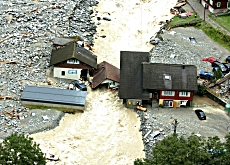
Still counting the cost of 2005 flood

Sufficient measures are not yet in place to prevent a repeat of the damage to large parts of Switzerland caused by the catastrophic flooding exactly one year ago.
Six people were killed and the final cost of the flooding has been estimated at SFr2.5 billion ($2.03 billion). Not included in the amount is the large sum needed for future flood control.
Three days of torrential rain led to the flooding and landslides. About two-thirds of Switzerland’s 26 cantons reported damage. Hardest hit was canton Bern and those in central Switzerland.
Two people died when the mountain stream running through the village of Brienz in the Bernese Alps spilled over its banks, destroying several houses. A landslide swept two firemen to their deaths in the canton Lucerne countryside.
Roads and railway lines that were washed away cut off villages for days, and for weeks in the case of the mountain resort of Engelberg. And the images of helicopters plucking Bern city residents from the roofs of their flooded houses went around the world.
When the waters finally receded, the cost of the damage became clear. Private insurers received 36,000 claims valued at SFr1.33 billion. Building insurance firms run by the cantons had to pay out SFr660 million.
A further SFr511 million in damage was done to public roads, railway lines and agriculture.
Swiss Solidarity, the fundraising arm of the Swiss Broadcasting Corporation, collected nearly SFr50 million in donations to cover the non-insured costs of flood victims.
In the immediate aftermath of the floods, several cantons got to work building dams and dredging rivers, and reviewed plans hatched following the “flood of the century” in 1999 to implement effective flood controls.
Hazard maps
They also speeded up the process to complete hazard maps for the country, which define areas at risk of flooding, rockslides and avalanches, and the Federal Office for Water and Geology promised to upgrade its early warning system.
Experts have said that the federal and cantonal authorities will have to spend billions of francs over the next few years if they want to prevent a repeat of 1999 or last year.
The town of Thun in canton Bern plans to build an underground pipeline, which will siphon excess water from Lake Thun, taking it beneath the town on its way into the river Aare. The city of Bern is considering a similar project.
A larger problem facing the canton is getting the 18 communities built near the banks of the river to agree on where and to what extent to widen the watercourse in order to create floodplains.
River widening
Canton Lucerne wants to have better flood control measures in place on its rivers by 2012, which includes the widening of the Kleine Emme.
Officials in Sarnen, the capital of canton Obwalden, are expected to present their plan in the coming months on how to increase the capacity of the outflow of the lake the town borders. Besides damage to buildings and roads, the floodwaters destroyed many historical documents valued at SFr10 million.
Measures costing around SFr7 million will soon be presented to voters in the popular ski resort of Klosters, where 145 building suffered flood damage.
The effort needed to coordinate policy among the federal, cantonal and municipal levels stands in the way of implementing effective measures quickly, a hydrology expert told swissinfo.
“The federal government is trying to provide the right direction by creating framework laws, but it is the cantons that have to implement them,” said Marc Zaugg of Zurich University.
The mayor of Brienz, Peter Flück, told the Swiss news agency, SDA, that the 2005 flood had increased people’s readiness to act, but added that the “devil was in the detail”.
What is nearly certain is that the Swiss will have to pay more for their insurance. The government is expected to raise the liability for railways, roads and buildings from SFr250 million to SFr1 billion.
If that happens, private insurance companies will respond by increasing the deductible rate of premiums from SFr200 to SFr500 next year.
swissinfo with agencies
Private insurance companies paid out SFr1.33 billion in claims. Cantonal building insurance firms valued their claims at SFr660 million.
The federal government has agreed to pay out SFr251 million to cover damage to public infrastructure including roads and railways.
A federal hydraulic engineering law was passed in 1991 demanding the introduction of measures to prevent flooding.
The 15-year-old law states cantons are to do whatever is necessary to protect their communities, including the widening of riverbeds and the building of dams and reservoirs.
It adds that wherever possible, natural river courses should be maintained or reinstated to the way they once were.

In compliance with the JTI standards
More: SWI swissinfo.ch certified by the Journalism Trust Initiative
















![The four-metre-long painting "Sonntag der Bergbauern" [Sunday of the Mountain Farmers, 1923-24/26] had to be removed by a crane from the German Chancellery in Berlin for the exhibition in Bern.](https://www.swissinfo.ch/content/wp-content/uploads/sites/13/2025/12/01_Pressebild_KirchnerxKirchner.jpg?ver=cb688ed5)














You can find an overview of ongoing debates with our journalists here . Please join us!
If you want to start a conversation about a topic raised in this article or want to report factual errors, email us at english@swissinfo.ch.